Newman Center Artwork Tour
A Catholic church is not simply a place IN which we worship God… but WITH which we worship God. As such, it is often adorned with colorful vibrant imagery to “offer to the Lord a fitting place to worship Him” (cf. Isaiah 66:1).
Imagery is not forbidden by the first commandment, which actually forbids us to worship a false God, or to fashion God in a way we find more pleasing. Shortly after receiving the commandments of God, His people rebelled against Him and Moses (Exodus 32). A consequence of rebellion was the appearance of “saraph serpents which bit the people so that many of them died” (cf. Numbers 21:6-7). God commanded them to “fashion a bronze serpent and place it on a pole… whoever shall look upon it shall be spared” (Numbers 21:9). Obviously, then it is not a dishonoring of God to do so. The honor paid to such images is not idolatry because we do not adore them.
The Son of God would take flesh of the Blessed Virgin Mary and “appear among us” (Titus 3:4)… the “visible image of the invisible God” (Colossians 1:15). Jesus Christ would make use of tangible, visible Creation in His Ministry of healing, teaching… the Cross Itself would become the visible symbol of salvation. The Church, therefore, makes use of visible images in much the same way that we keep images (photos, paintings, keepsakes, etc) of those whom we love on earth.
The Church makes use of imagery because a) human beings really need the visual as a help to belief; and b) we derive great benefit from the veneration of sacred images:
Through them effective, and sometimes supernatural graces are obtained. There are, after all, instances of miraculous pictures and statues, as well as crucifixes.
They help us avoid distractions while praying by fixing our attention.
They serve as something of an encouragement to imitate the virtue made visible.
They are an “excellent means for instructing the faithful in religion.” The greatest artists in the world have been Catholic artists. Their greatest masterpieces treat of religious subjects. Even the most unlettered can understand a picture.
Beuronese Art
The images you see about you in our Newman Center Chapel here at ASU are of a style of art developed by the monks of the Archabbey of Beuron in Baden-Wurttemburg, Germany. In the late 19th and early 20th centuries the Beuron Art School, with its emphasis on ancient art forms, in particular Byzantine art fused with Roman and Egyptian lines, was influential on religious art of the period. One of the biggest exhibits of this type of art in the United States is at Conception Abbey in Missouri, founded as a daughter house of the Archabbey of Beuron.
Windows into heaven is often how Christian iconography is described. Beuronese iconography, is not as stark and esoteric as is eastern Christian icons… Beuronese style is more accessible to the Roman mind because of its textured dimensions, development of scenes and use of color, often depicting plants, even animals in the landscape. Another signature element of Beuronese Art is to include a brief verse from scripture in the background somewhere.
Fr. Rob Clements commissioned Ruth Ristow-Stricklin in 2011 to prepare and execute the panels we now devotedly display and offer to the community here at ASU. These spectacular icons are actually painted on canvas and then affixed to the wall utilizing a Greek practice. Eventually, all the wall space will be covered in such iconography, making the Life of the Lord Jesus, His Mother, and scenes from the Gospels come alive!
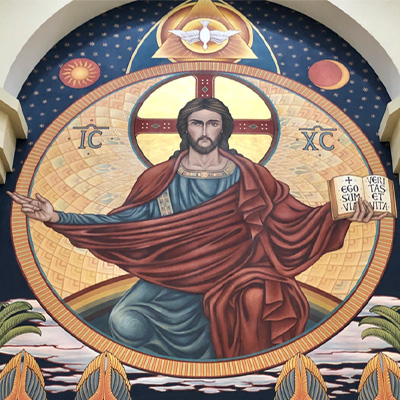
Christ Pantocrator
This is the main image located directly behind the main altar. It depicts the Lord Jesus Christ, seated upon the cherubim, coming in glory at the end of time. One Hand is extended in blessing, and the other hold the Book of Life in which our names are to be inscribed. Rendered in Latin is the inscription (John 14:6): I AM the Way, the Truth, and the Life.
The artist has made use of an ancient technique in her version of the Pantocrator (Judge of the Living and the Dead). It’s found in the Eyes of Our Lord: one is the Eye of Mercy, the other the Eye of Scrutiny or Judgment. Stand at the back of the Chapel… Our Lord seems as if He’s almost frowning: we note more the Eye of Scrutiny. The closer we come to the front, we begin to notice that Our Lord is actually smiling: we note more the Eye of Mercy.
Much of the imagery – the angel choir, the river that flows through the City of God – is derived from the Book of Revelation. The Lamb Who was slain now lives! The River of God flows into the tabernacle where the Blessed Sacrament is housed. The words of St. John the Baptist are utilized above in the Latin (John 1:29): Behold the Lamb of God Who takes away the sins of the world.

The Hidden Life
The other wall paintings make visible events in the Gospels, the Life of the Blessed Virgin Mary; scenes that may not be altogether well-known or oft-depicted, but in some fashion correspond to significant moments in our own lives: growing up, discovering faith, meeting our spouse, being forgiven, sacraments. As of 2018, two panels have been completed, with an eye toward an additional 6-8 more renditions.
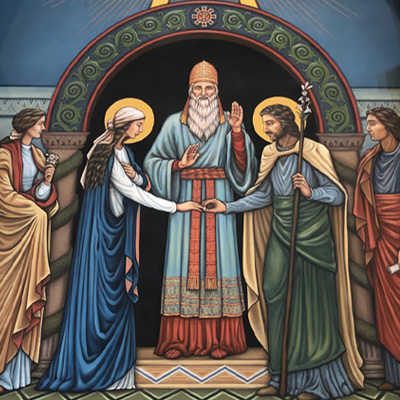
The Betrothal of the Blessed Virgin Mary to St. Joseph
The image immediately to the left as one faces the main altar is a scene from the Gospel of St. Luke (Luke 1:26-28), which is cited in the Latin inscription: A man named Joseph [was betrothed to a virgin]… and the Virgin’s name was Mary. The Jewish priest from the Temple in Jerusalem – St. Simeon – witnesses the Betrothal (engagement leading to marriage) of the Blessed Virgin Mary to a widower – St. Joseph – of the House of David. Christian tradition holds that it was Simeon who arranged the marriage, as he had discerned that Our Lady was to be the vessel through whom God would take flesh and appear among us. Joseph it is who will serve as Protector of the Holy Family and foster-father to Our Lord Jesus Christ.
What is college but often a time in life when we discern our vocation, which for most of us is marriage – sometimes meet our spouses; grow in wisdom and faith and love.
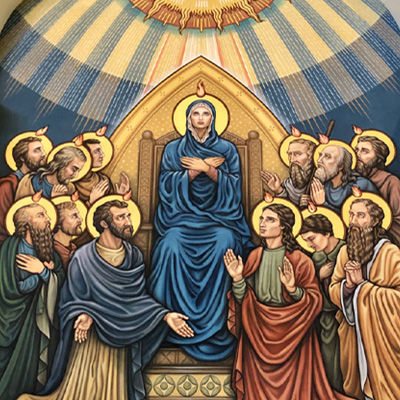
The Day of Pentecost
The image immediately to the right as one faces the main altar is a scene from the Acts of the Apostles (Acts 1:12-14; 2:1-4): the Sunday of Pentecost, when the Holy Spirit appeared visibly as in countless tongues of fire and rested upon the Blessed Virgin and the Apostles. This same Spirit is given to us sacramentally in Confirmation. Cited in the inscription is a scripture antiphon that’s been used at Mass on the Day of Pentecost since the 3rd century (Wisdom 1:7): The Spirit of the Lord fills the whole world.
The Betrothal and Pentecost shrines are made possible by the generosity of Dr. & Mrs. Peter Labadie as a memorial to Dr. William L. & E. Ursula Labadie.
Help Us Complete Our Devotional Paintings
Contact our Development Office for more information on helping us complete our panels of devotional paintings! They may be funded as memorial gifts to remember family, friends, special intentions.
Mr. Chris Tawney
Phone: 480-967-7823
Email: development@asucatholic.org
Other Planned Images
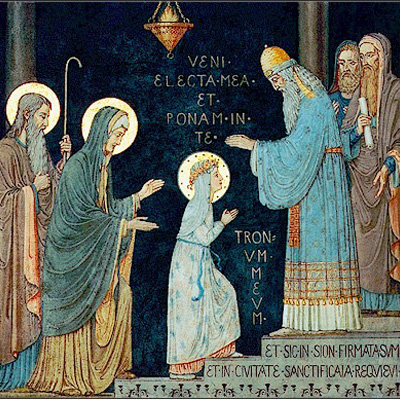
The Presentation of the Blessed Virgin
Presentation was a Jewish ritual by which a young girl was “consecrated to God.” Mary of Nazareth would have, indeed, been presented to the Lord in the Temple in Jerusalem. Some girls would be selected for the Temple School, which Christian Tradition has held Mary entered. So our apocryphal image literally depicts “Mary goes off to school”! Joachim and Anna, the parents of Our Lady, present her to Simeon in the Temple. A print of this image may be seen in the corridor outside the Main Chapel. The inscription in the Latin is taken from the Psalms: Come my chosen one for in you I shall set up My Throne, and Zion shall remain forever the King’s holy city.

The Rich Young Man
(Luke 18:18-23) A young man who was wealthy approached Jesus and asked Him, “Good Master, what must I do to gain life eternal?” What must I do? Discovering our vocation in life involves discerning, questioning, maybe trial and error; is the Lord a part of the process?

The Woman at the Well
(John 4:3-32) Passing through the region of Samaria, the Lord Jesus has a conversation with a woman drawing water from a well at midday. He calls her to a higher way of living, and essentially interprets her own life for her. She’s the first person to whom Jesus reveals Himself as the Christ… and she runs and tells the whole town… who also come to belief. The Latin inscription is the woman’s own words, Come and see, someone who known me and has told me my entire life.
Experiencing forgiveness, forgiving ourselves is often the hardest thing to do. This painting calls to mind a foundational Christian principle: forgiveness, and living with God at the center of life.
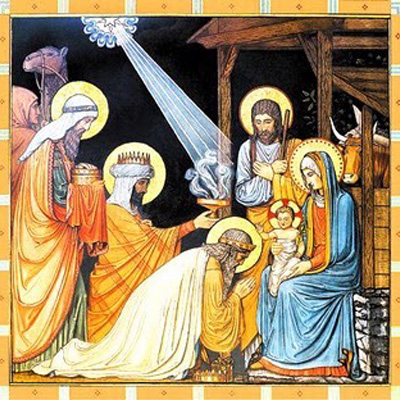
The Epiphany
(Matthew 2:1-11) Behold, Magi from the East arrived in Jerusalem inquiring, “Where is the newborn King of the Jews? We have seen His Star in the East and have come to offer Him homage.” They set out for Bethlehem, following the star that… halted over the place where the Child was. The sight of the Star filled them with joy… entering the house they saw the Child with His Mother, Mary. Falling to their knees they did Him homage, and offered Him gifts of gold, frankincense and myrrh.
The process of “conversion” in our lives involves moving from what is known to what is not known… the humility to ask directions… to give of ourselves in love. The switch gets flipped, our eyes are opened, and we are ready to give our all for love of God.

The Call of the First Disciples
(John 1:35-51) Andrew asked Jesus, “Rabbi, where do You stay?” And Jesus replied, “Come and see.”… Andrew found his brother, Simon Peter, and told him, “We have found the Christ.” The next day, in Galilee, Jesus met Philip and said, “Follow Me.” Philip found Nathanael and told him, “We have found Him of Whom Moses and the prophets wrote: Jesus of Nazareth.” Nathanael asked, “What good can come from Nazareth?” Philip replied, “Come and see.”
The call to follow the Lord is often built up as a “chain reaction,” in mutual support from others. It’s also a call often met with skepticism, but the Lord always invites… He proposes, He never imposes.
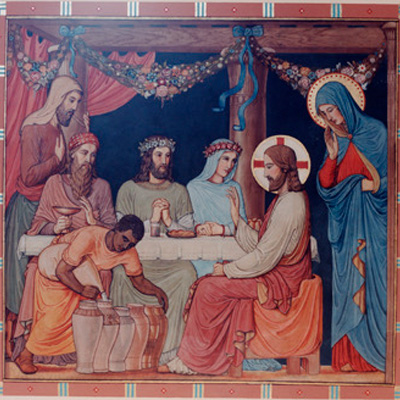
The Wedding at Cana
(John 2:1-12) There was a wedding at Cana in Galilee and the Mother of Jesus was there.
Wherever God shows up… there is abundance of life, joy, love. Our Lord salvages an occasion that should be an occasion of joy! And He does so at the request of His Mother. Never underestimate what asking for help from the Blessed Virgin Mary might bring about.
Questions and Answers
Some questions from some of our Newman Community members, students, visitors.
The “beam” supported by two pillars that marks off the sanctuary is actually a rather common feature to churches in Italy (where it is known as a templon) and in England (where is often referred to as a “Rood Beam.” “Holy Rood” is a peculiar British expression referring to the Cross of Christ. The beam is a decorative element that displays the Crucifix surmounted, but it also “houses” the altar itself, much like a baldacchino (a canopy supported by four pillars)does in a number of churches even here in Arizona. There is a connection to Jewish Temple practice outlined in the Old Testament of the Bible.
And the words on its face are taken from the New Testament… the Book of Revelation: You were slain, Lord, and with Your Blood You have purchased for God people of every tribe, tongue, and nation… and have made them priests to serve our God.
(There’s some Hebrew worked into the Betrothal panel, just look up at the top! It’s the Name of God: I AM WHO AM.) Our thinking was somewhat practical in addition to being devotional. On the main campus at ASU, there are close to 200 languages and dialects spoken by people from every corner of the world. Consequently, we elected to go with the language of the Church – Latin – which is also the very first common language (of the times) into which the scriptures as we know them were translated.
Adoration of the Blessed Sacrament as we know it today… it’s been a staple in Catholic life for the last millennium! A consecrated Host taken from the Tabernacle (gold receptacle behind the main altar) and place in what is called a monstrance… it is then placed on the main altar for the faithful to pray and worship the Lord Who is Present in the Blessed Sacrament.
When our new facilities were being planned and constructed, the desire to have Perpetual Adoration on-site was identified… and the Adoration Chapel was made possible through an exceptional gift of the John Campo III family as a remembrance of Mr. Campo’s mother and father. It is also where the intercession of St. Philomena – the 3rd century virgin and martyr of Italy – is invoked.
In the Chapel, the Blessed Sacrament is placed behind a sheet of bullet-proof glass that covers a niche in the reredos (decorative back wall) that depicts angels adoring the Lord. Words (in Latin) frame the reredos are taken from the Sequence (liturgical poetry) of the Feast of Corpus Christ (Most Holy Body and Blood of Christ):
Behold the Bread of Angels, given to us as food for the journey, the very Bread which is the Son of God and therefore must not be wasted.
In addition, the entry to the Chapel is framed with stained glass from the Adoration Chapel of our much-loved former facility and invites the faithful to enter and find rest. This window was made possible in 1986 by Sister Giovanna Stein, O.P., as a memorial to her parents.
At the back of the Main Chapel, above the loft, is the stained glass depicting the Blessed Mother of God, and utilizes a style reminiscent of 15th century practice. Our beloved “Old Church” was the first Catholic church in the Valley dedicated to the Blessed Virgin Mary, so it’s intended as something as a connector of “old with new.” This window is the gift of Dr. & Mrs. Peter Labadie as a memorial to Dr. William L. and E. Ursula Labadie.
